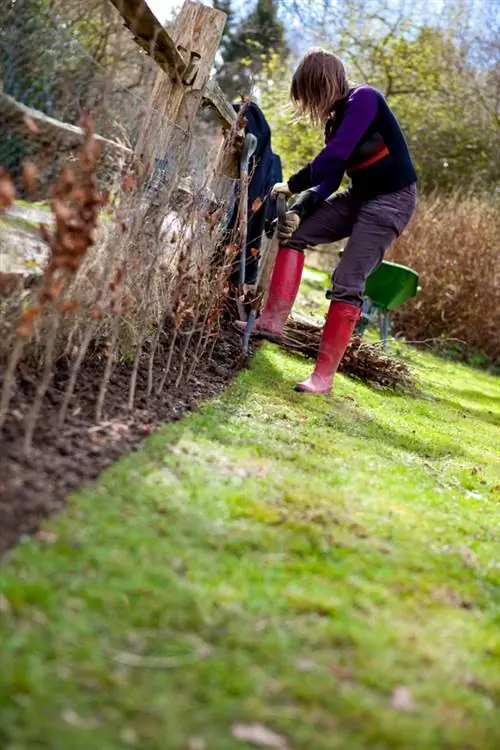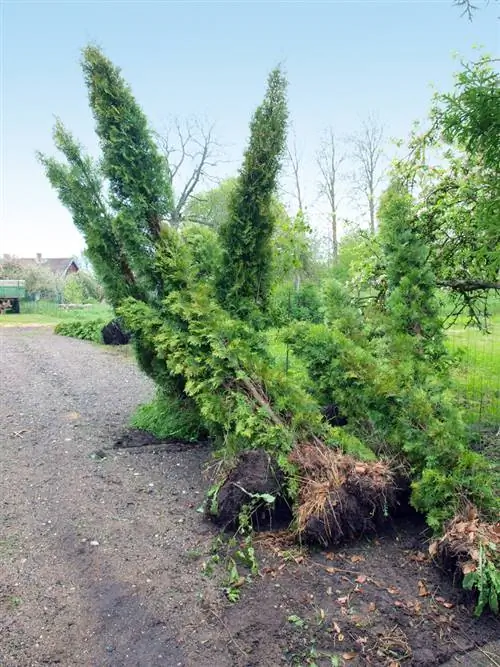- Author admin [email protected].
- Public 2023-12-16 16:46.
- Last modified 2025-06-01 06:02.
If hobby gardeners create a Benje hedge strictly according to the original concept, the biodiversity leaves a lot to be desired. It takes 50 to 120 years for a pile of dead wood to develop into a mini-ecosystem in Benjes style. If you don't want to wait that long, you can speed up the process with additional planting. This guide explains which plants will make your Benje hedge a successful project.

Which plants are suitable for planting a Benje hedge?
In order to plant a Benje hedge and promote biodiversity, native wild fruit trees such as serviceberry, blackthorn, cornelian cherry and black elderberry should be planted. In addition, wild perennials such as mullein, wild teasel, hollyhock, viper's head or elecampane can beautify the transition to the Benje hedge.
Planting native wild fruit trees in a targeted manner - the best species and varieties
You can wait a few decades and be surprised at which seeds settle in your Benje hedge as greenery. Alternatively, plant pre-grown wild fruit trees to accelerate the process of creating a species-rich natural wall with a privacy effect. If you plant the following species and varieties along the outer edges, small mammals, birds and insects will arrive in droves in no time:
- Rock pear (Amelanchier lamarckii) with white flowers in April and juicy fruits in autumn
- Blackthorn (Prunus spinosa), white fairytale flowers in April and May, black-blue berries in autumn
- Cornelian cherry (Cornus mas), golden yellow spring blossoms, followed by nutritious fruits in late summer
Black elderberry, also known as lilac berry, is a must in the Benje hedge. The large shrub thrives in any normal garden soil and has a lush dress of nectar-rich flowers. The black berries are a welcome feast for numerous bird species.
Wild perennial stripes - decorative transition to the Benje hedge
Is the direct view of the bush wall of a Benje hedge in the early stages not to your liking? Then enhance the appearance with a strip of wild perennials as a decorative transition. The sunny sides of the wall are particularly suitable for this creative design trick. We would like to recommend the following species for this purpose:
- mullein (Verbascum), e.g. B. the purple-pink variety 'Pink Pixi' from June to August; 150 to 220 cm
- Wild teasel (Dipsacus sylvestris) with pink cylinder flowers from July to August; 150 to 200 cm high
- Hollyhock (Althaea rosea), e.g. B. the black-flowering 'Nigra' from July to September; 200 to 250 cm high
- Viper's Head (Echium vulgare), crimson-red flower candles from June to August; 40 to 80 cm high
One of the most stately wild perennials comes with huge, yellow cupped flowers more than 10 cm in diameter. Real elecampane (Inula helenium) thrives in dense clumps and reaches a height of 180 to 200 cm.
Tip
Proper care of a Benje hedge sometimes requires drastic intervention in the greenery. To ensure that floral invaders such as birch or goldenrod do not overgrow the lovingly created deadwood hedge, they must be cut back regularly and radically.






